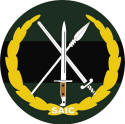
The Namibian Defence Force (NDF) comprises the national military forces of Namibia. It was created when the country, then known as South West Africa, gained independence from apartheid South Africa in 1990. Chapter 15 of the Constitution of Namibia establishes the NDF and defines its role and purpose as, " ... to defend the territory and national interests of Namibia".

The South African Army is the principal land warfare force of South Africa, a part of the South African National Defence Force (SANDF), along with the South African Air Force, South African Navy and South African Military Health Service. The Army is commanded by the Chief of the Army, who is subordinate to the Chief of the SANDF.

The South African Military Health Service is the branch of the South African National Defence Force responsible for medical facilities and the training and deployment of all medical personnel within the force. Though unusual, as most national militaries integrate their medical structures into their existing service branches, the SANDF regards this structure as being the most efficient method of providing care and support to the SANDF's personnel.

The South African Army Infantry Formation supervises all infantry within the South African Army.

The Zimbabwe National Army (ZNA) is the primary branch of the Zimbabwe Defence Forces responsible for land-oriented military operations. It is the largest service branch under the Zimbabwean Joint Operations Command (JOC). The modern army has its roots in the Rhodesian Army, which was raised between 1963 and 1964 after the breakup of the Federation of Rhodesia and Nyasaland. A Joint High Command created in March 1980 to oversee integration of the formerly belligerent Rhodesian Security Forces, Zimbabwe African National Liberation Army (ZANLA), and the Zimbabwe People's Revolutionary Army (ZIPRA) officially established the Zimbabwe National Army in late 1980, nearly a year after the end of the Rhodesian Bush War.

The Rhodesian Security Forces were the military and security forces of the Rhodesian government. The Rhodesian Security Forces consisted of a ground force, the Rhodesian Air Force, the British South Africa Police, and various personnel affiliated to the Rhodesian Ministry of Internal Affairs. Despite the impact of economic and diplomatic sanctions, Rhodesia was able to develop and maintain a potent and professional military capability.
The South African Army is divided into functional branches, known as corps. Most consist of units, but some, such as the SA Staff Corps, consist only of personnel who are assigned to headquarters and units. The following is a list of corps established since 1912; those which still exist are shown in bold.

44 Parachute Brigade was a parachute infantry brigade of the South African Army. It was founded on 20 April 1978, by Colonel Jan Breytenbach, following the disbandment of 1 SA Corps and the battle of Cassinga. Upon formation, the brigade was commanded by Brigadier M. J. du Plessis, who was assigned the task of establishing by working with the Parachute Staff Officer, Colonel Jan Breytenbach. At the time du Plessis was the commanding officer of the Orange Free State Command and had previous experience serving in 1 Parachute Battalion. Breytenbach had also been a member of 1 Parachute Battalion and had also founded the South African Special Forces Brigade and 32 Battalion. The location that was chosen for the brigade's headquarters was in the lines of the OFS Cmd Headquarters, next to the old Tempe Airfield in Bloemfontein.

The School of Artillery is the South African Army's specialized artillery training school

The South African Army Training Formation is the controlling entity of all South African Army training units. The Formation was established in April 1999 and mandated to provide, maintain and sustain landward common training to the SA Army.
Edward George McGill Alexander is a former South African Army officer.

The South African Infantry School is within the Army Base in Oudtshoorn, Western Cape. The Infantry School, now at Oudtshoorn, was established in November 1953, after a history dating back to the South African Military School in Bloemfontein, established in 1912. It is the Infantry’s “centre of excellence” and offers a number of infantry-specific courses to regulars and Reservists.

Eastern Province Command was a command of the South African Army.

7 South African Infantry Division was a formation of the South African Army, active from the 1960s to 1999.

The South African Army Signal Formation is a formation/corps of the South African Army.
Lt Col Mimy Matimbe is a gunner officer in the South African Army and was appointed as the first female Commanding Officer in the South African Army Artillery Formation when she took over command of 4 Artillery Regiment on 7 April 2017.

81 Armoured Brigade was a Formation of 8th Armoured Division, a combined arms force consisting of armour, mechanised infantry, and mechanised artillery.

73 Motorised Brigade was a Formation of 7th Infantry Division, a combined arms force consisting of infantry, armour and artillery.
















